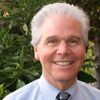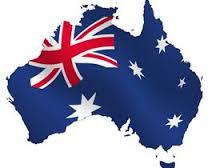Australia Day (January 26th) has come and gone. The day marks the anniversary of the 1788 arrival of the First Fleet of British ships at Port Jackson, New South Wales and the raising of the flag of Great Britain at Sydney Cove by Governor Arthur Phillip, e.g. the "beginning" of Australia. As you can imagine in our post-modern world, the indigenous Aboriginal people and many Australians feel the date denotes the beginning of the end of the original inhabitants of this continent. These groups do not celebrate but mark the day much in fashion Native Americans do of Columbus Day in the United States.
But overall it's a day that in Melbourne seemed to combine both July 4th and American Labor Day, because it also marks the end of the summer vacation for most school children. There are celebrations with parades, military plane flyovers and the front-page announcement of the Australian of the year (David Morrison, the former army chief) along with a long list of winners of the Order of Australia. As I read this list in the Age, I caught Rod Laver's name under the "Companion (AC)" in the General Division of the Order of Australia.
I've been a tennis player and enthusiast for more than fifty years. I grew up only a few streets from the fabled West Side Tennis Club of Forest Hills where the Nationals were held for seventy plus years until the U.S. Open (moved to Flushing Meadow in 1978. I got to see all the great Aussie tennis stars of the 1960s and 1970s including Ken Rosewall, John Newcombe, Roy Emerson, Tony Roche along with "The Rocket," Rod Laver, who had turned pro during the amateur era but was allowed to play again when the Open era began in 1968.
Laver is the only man to twice win the Grand Slam of tennis: Wimbledon, the French Open (Roland Garros), the U.S. Open and the Australian Open. Indeed the main stadium of the Australian Open is named after him (at the U.S. Open Arthur Ashe posthumously received the same honor). Thus, I was especially curious about what exactly this AC honor for Laver was all about.
Apparently in 1975, Queen Elizabeth established a separate order of chivalry especially for Australians. Prior to then, an Australian could only achieve a British title (sir or dame). In fact initially, the highest honor an Australian could achieve under the new Australian order was knight or dame. However, in 1986 under pressure from the Australian Labor Party, the Queen abolished the Australian order of knight and dame.
Tony Abbott, the much maligned, recently deposed prime minister, in 2014 revived the knight/dame Australian title to great criticism and ridicule. His first "Australian" knight was actually the Brit, Prince Phillip, Queen Elizabeth's husband!!! One of Malcolm Turnbull's first acts as the replacement PM was to once again sack the sir/dame honor for Aussies only 18 months after it had been reinstituted.
This whole notion of peerage is totally weird for an American. We have our Presidential Medals of Honor (for the military) and the Presidential Medals of Freedom (for civilian achievement in national security, world piece or cultural or public achievement) which probably occupy analogous places of stature in the American firmament. But once again how each country separated from mother England, one by armed revolution and the other by peaceful evolution, continues to influence the American and Australian societies to this day.
Other political groups besides the indigenous Australian people also took advantage of Australia Day to promote their interests. Eight of the nine Australian State premiers (each Australian State has its own parliamentary government) along with General Morrison, pledged their efforts to make Australia a republic, breaking the final link with Great Britain and British monarchy. At present Australia remains a federal constitutional monarchy with Queen Elizabeth the ostensible head of state. The Governor General, the British representative to the Australian government, last interfered in a major way with Australian government in 1975 during the "Supply" constitutional crisis which led to the dissolution of the government of Prime Minister Gough Whitlam.
In the intervening forty years there have been various efforts to formally end all ties with the Queen. In 1999 a solid majority of 55% of Australians voted in a national referendum against becoming a republic. Since then though the question has been yet again raised many times. The issues are symbolic but carry with it some sense of Australian society becoming more progressive. Indeed in the 1999 referendum the more conservative (Liberal Party) state of Queensland was much more in favor of retaining the monarchy compared to the liberal (Labor) state of Victoria.
But there are also elements of a popularity/celebrity contest when the voters consider the question of an Australian republic. Polls reflected a higher interest in Australian republicanism when Prince Charles was having his problems with Diana and when his subsequent marriage to Camilla occupied the tabloids. Since his children, William and Harry, have reached adulthood, marriage and have had children of their own, their popularity along with a growing respectful astonishment of Elizabeth's longevity as Queen, have reduced interest in Australian republicanism (note: I am so not into British monarchy stuff that I had to Google "Prince Charles' sons" to come up with the names of William and Henry).
Malcolm Turnbull, the current PM of the country and leader of the Liberal/National coalition, led the previous "Yes" effort in 1999 referendum. He has stated without qualification that he thinks it's a poor time to revive an attempt to officially separate from the monarchy.
Anyway, getting back to tennis, I guessed that Laver might publicly receive his AC during a break in the Australian Open on Australia Day. Indeed, I was in Laver Stadium when the Rocket came out to Center Court between matches and was honored. In very un-American fashion he graciously received the honor and a facsimile trophy of his Australian Open championship (they didn't give facsimile trophies in 1969) without giving a speech or anyone asking him in an interview on the court "how he felt." He just smiled and walked backed into the stands.
Regarding the Open, I must say the three stadia, Laver, Margaret Court (named after Australia's greatest woman tennis player - a contemporary of Laver's) and Hisense (named after an appliance/electronic Chinese company that paid for six year naming rights to the stadium) are far more fan friendly compared to the vertiginous experience of Arthur Ashe Stadium at the U.S. Open. All the seats at the Australian Open are relatively close to the court. The corporate boxes are above the main seating sections. In the U.S., it's just the opposite. Any seats (the majority) above the corporate boxes are poor viewing seats for tennis.
Novak Djokovic won again, but Serena Williams shockingly lost in the women's finals to the German, Angelique Kerber. I saw a couple of great matches up close. The Australian Tennis Open was one of my premier anticipated events in living in Melbourne for a year and it delivered. Through my San Francisco friends, Laura and Arnie (who have been to 20 consecutive Australian Opens) I met Fred Stolle and Cliff Drysdale. Stolle was particularly known as an Aussie doubles star during the 1960s and ended his career playing with Drysdale, a South African. They both went on to years of television commentary. Drysdale can still be seen/heard on ESPN. They were both extremely modest and gracious. I was a gaping adoring groupie. It was great fun.
My wife, Denise, and I did a weekend tour of the Bendigo/Daylesford/Ballarat (north and northwest of Melbourne). Between Bendigo and Daylesford while stopping at Heathcote, we saw our first wild 'roos, a mom and her Joey. On our trip we also counted overall three kangaroo carcasses at the side of the road - road kill - as I've mentioned in the past. Many signs on the road with "high risk for the next 10 kilometers" with a picture of a 'roo remind the driver to be especially alert for an errant kangaroo on the road which can significantly damage a car (and kill the kangaroo).
Today while circumperambulating Lake Daylesford we saw yet another strange Australian mammal, an echidna (also called a spiny anteater) amble across the road. They look like a cross between a porcupine, armadillo and anteater. He (it) was actually very cute.
Our lesson in Australian lingo is relatively short in this Letter:•pong: an unpleasant smell; stink. Or to have a disagreeable smell (1915-1920 of obscure origin).•wrack: seaweed or other vegetation cast on the shore (4th definition of wrack). The Age headline writer wins the award for "Rank, Rotten Wrack Wreaked Havoc on Nostrils."•hoon (I may have covered this one once before): a lout or hooligan, especially a young man who drives recklessly.

